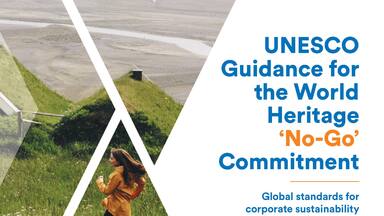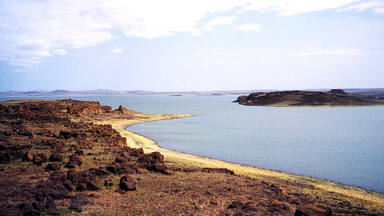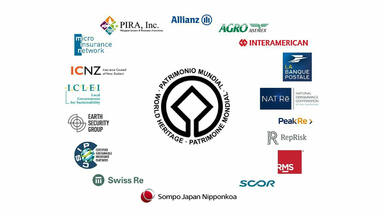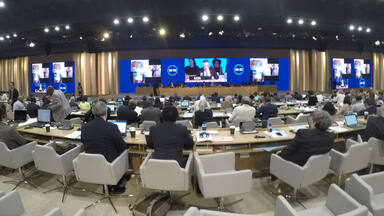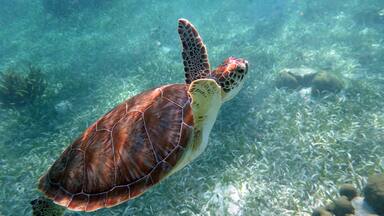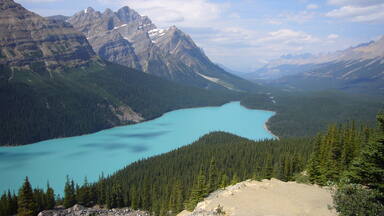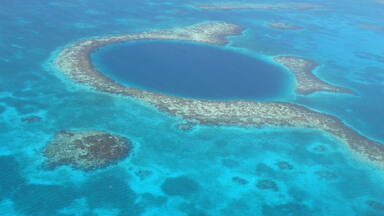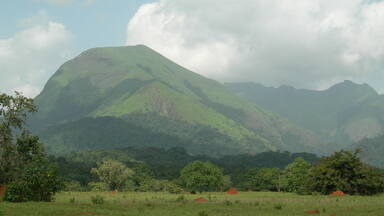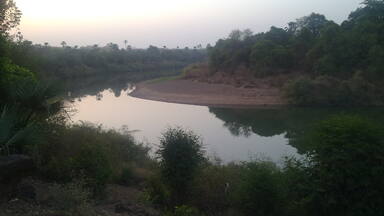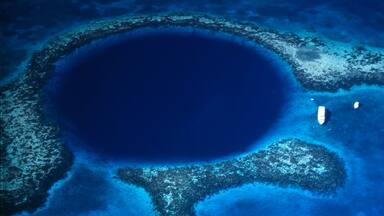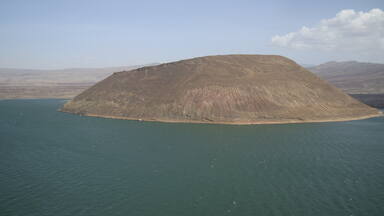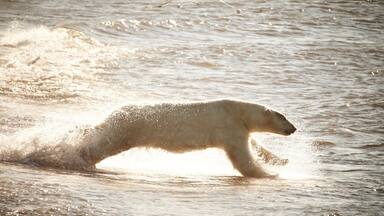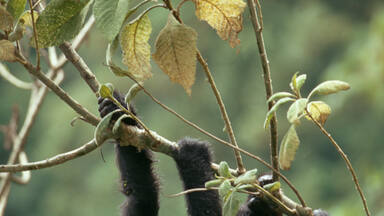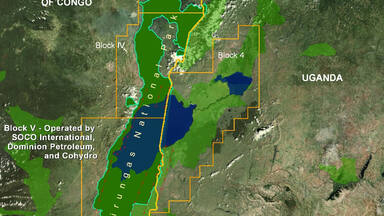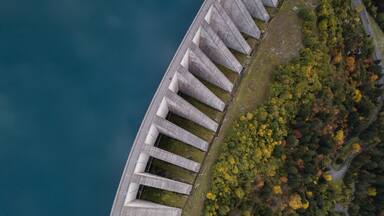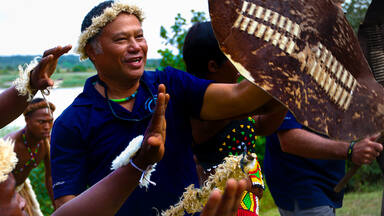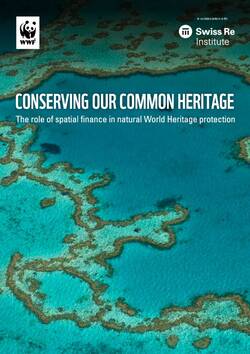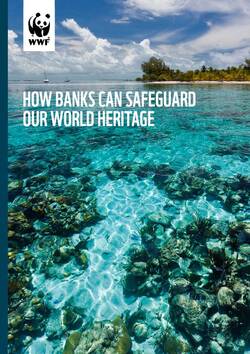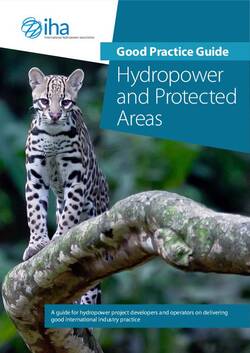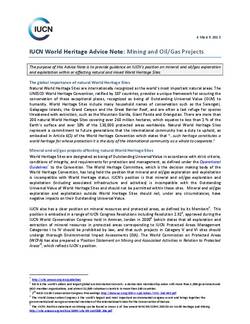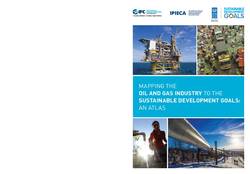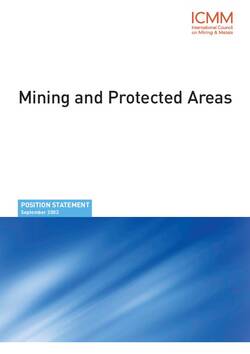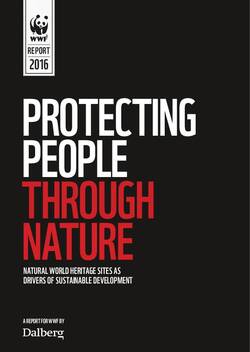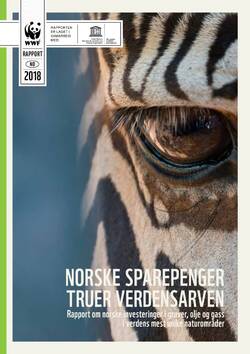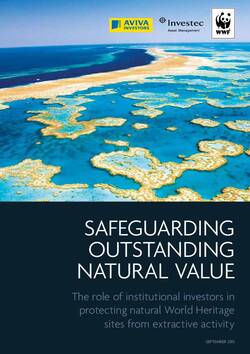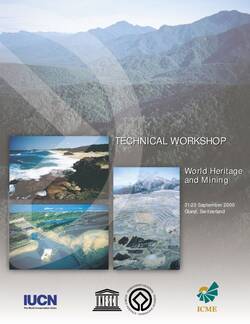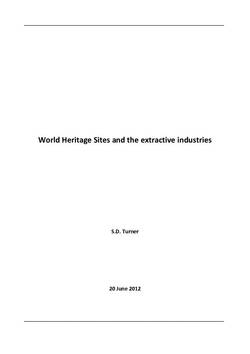Across the extractives, finance, insurance and hydropower sectors, among others, major public and private companies and industry associations have committed to protect UNESCO World Heritage sites. They have often demonstrated this by respecting UNESCO World Heritage sites as no-go areas for harmful industrial activities and large-scale development projects, which is known as the World Heritage ‘no-go’ commitment.
The World Heritage ‘no-go’ commitment
Sustainable business conduct avoiding all harm to UNESCO World Heritage sites
UNESCO Guidance for the World Heritage ‘no-go’ commitment
Global standards for corporate sustainability
Database of commitments
Explore the corporate sector commitments and strategies for safeguarding World Heritage
How to lodge a World Heritage ‘no-go’ commitment
Instructions on how to register company commitments in the UNESCO database
The World Heritage ‘no-go’ commitment
While UNESCO World Heritage sites exemplify some of the planet’s most exceptional places, the threats to these sites have been rising steadily for decades, mainly due to harmful industrial activities and large-scale development projects ranging from oil and gas exploration or exploitation, mining, dams and hydropower projects, and transportation infrastructure, located both inside and outside property boundaries.
Due to their environmental and social risks, the extractive industries (mining, oil and gas exploration and exploitation) pose a major threat to World Heritage, with almost a hundred sites affected by proposed or realised activities for mining, oil, gas, or quarrying, according to the State of Conservation information system. Another important threat is the construction of dams, with more than 50 UNESCO World Heritage sites reporting potential impacts from water infrastructure projects underway or planned.
The World Heritage Committee has therefore made clear statements on certain activities which are considered incompatible with the UNESCO World Heritage status, including mining, oil and gas developments and dams with large reservoirs. With the growing public attention and importance of corporate sustainability, many companies have recognised the need to protect UNESCO World Heritage sites as no-go areas for harmful activities and adopted policies that demonstrate this commitment.
Any corporate sector operations negatively impacting World Heritage run a considerable risk of affecting the financial return of companies through possible reputational damage, litigation, compensation claims, shareholder divestment and reduced access to financing. All of this has led to a better integration of international designations, including for World Heritage, in company policies and due diligence processes as part of a broader effort by the corporate sector to measure and manage environmental, social and governance risks.
Over the past two decades, the corporate sector, including public and privately-owned companies from different industries and financial institutions have pledged to protect UNESCO World Heritage sites by refraining from undertaking or funding activities within sites, their buffer zones or broader setting, which could damage sites and their Outstanding Universal Value (OUV). These include policies which primarily avoid negative impacts, but additionally support only those activities that contribute positively to management and conservation of UNESCO World Heritage sites. This is generally known as the World Heritage ‘no-go’ commitment.
The private sector pitches in
World Heritage n°102 - June 2022
World Heritage sites require an enormous number of resources for their protection. Conservation needs are met in different ways by governments, vibrant communities, or donors of many types. But increasingly the private sector is taking action with a powerful impact on conservation and management.
UNESCO guidance for the World Heritage ‘no-go’ commitment
To meet global sustainability standards, UNESCO strongly recommends companies to develop comprehensive strategies for safeguarding World Heritage.
‘UNESCO Guidance for the World Heritage ‘No-Go’ Commitment. Global standards for corporate sustainability’ aim to provide companies with standardized, industry-wide guidance to set their strategies so that they protect all UNESCO World Heritage sites in their diversity, today and in the future. The guidance complements the toolkit for assessing impacts from projects on UNESCO World Heritage sites published in 2022.
These guiding principles are based on the Equator Principles, the UN Global Compact, UN Principles for Sustainable Insurance (UNPSI), UN Principles for Responsible Investment (UNPRI), the International Finance Corporation (IFC) performance standards, the OECD guidelines for multinational enterprises, civil society input such as the WWF report “How Banks can Safeguard our World Heritage”, as well as advice from the corporate sector and the technical Advisory Bodies to the World Heritage Committee – IUCN, ICCROM and ICOMOS.
Database of commitments
As of November 2022, more than 50 World Heritage ‘no-go’ commitments and other World Heritage safeguard policies have been endorsed by the corporate sector. These include companies from the extractive industries and other key sectors, finance and insurance industries, development finance institutions as well as signatories to the Equator Principles and the UN Principles for Sustainable Insurance. From other sectors, the International Hydropower Association (IHA), building materials CEMEX, the World Rowing Federation and the Responsible Jewellery Council (RJC) are among those to have pledged to protect UNESCO World Heritage.
Milestones in the World Heritage 'no-go' commitment
In 1998, due to growing concern, the UNESCO World Heritage Centre, IUCN and ICOMOS started discussing the issue of extractive industries and their impact on “protected areas and other ecologically sensitive sites” with the International Council of Metals and the Environment (ICME), currently known as International Council on Mining and Metals (ICMM), which represents 26 of the largest mining companies in the world.
Also in 1998, the World Heritage Committee had its first in-depth discussion on mining and World Heritage sites owing to uranium mining in Kakadu National Park UNESCO World Heritage site in Australia. An informal contact group on mining and World Heritage sites was established in the same year and presented to the World Heritage Committee the following year in Marrakesh in 1999.
Following the World Heritage Committee’s request, the World Heritage and Mining technical workshop was organized in September 2000 by IUCN, ICME and the UNESCO World Heritage Centre at IUCN Headquarters in Switzerland. The World Heritage Committee discussed again the issue of World Heritage and Mining and noted the recommendations of the workshop at its subsequent session in 2000.
Extractive industry
In 2003, the International Council on Mining and Metals (ICMM) made a pioneering statement to no longer pursue mining or oil projects in UNESCO World Heritage sites and that any activities in the vicinity of these sites would be rigorously evaluated to avoid impacts on their OUV. This marked the start of the ‘no-go’ commitment and led the way for the corporate sector to respect UNESCO World Heritage sites as no-go areas for the extractive industry.
Later that year, Shell became the first private sector company in the oil industry to make a similar commitment, abandoning plans to explore for oil and gas in the Sundarbans region of Bangladesh, a World Heritage site with the world’s largest mangrove forest.
Since then, the World Heritage Committee promoted the ‘no-go’ commitment as best practice in many of its decisions in response to threats posed by extractive activities to UNESCO World Heritage sites. At its 37th session in 2013, the World Heritage Committee adopted Decision 37 COM 7 (Part III), urging all States Parties to the World Heritage Convention and the leading industry stakeholders, to respect the ‘no-go’ commitment by not permitting extractives activities within UNESCO World Heritage sites, and by making every effort to ensure that companies operating in their territory cause no damage to World Heritage sites, in line with Article 6 of the World Heritage Convention.
The World Heritage Committee appealed in 2012 and 2013 to companies with exploration permits infringing on the Virunga National Park in the Democratic Republic of Congo, Africa’s oldest national park and the first natural site on UNESCO’s World Heritage List. In 2013, under pressure from the civil society, TOTAL (now TotalEnergies) pledged to refrain from prospecting or exploiting oil and gas in natural heritage sites. Subsequently, SOCO (now Pharos Energy) agreed in 2014 not to undertake or commission any exploratory or other drilling activities within the Virunga National Park World Heritage site.
In 2015, Tullow committed to remain out of UNESCO World Heritage sites, which was welcomed by the World Heritage Committee. The company had received a licence to explore for oil in an area overlapping Kenya’s UNESCO-designated Lake Turkana National Parks World Heritage site, which had led to World Heritage Committee’s appeals in 2012 and 2013.
In 2018, IPIECA, a global oil and gas industry association, recognized the importance of the World Heritage Committee’s ‘no-go’ position on extractives in their Sustainable Development Goal (SDG) Atlas, created with the International Finance Corporation (IFC) and the United Nations Development Programme.
Eni (in 2019), bp (in 2020), and Equinor (in 2021) are some of the energy companies to have also pledged to protect UNESCO World Heritage sites.
Financial institutions
Investors and banks can have a significant impact on economic and industrial activities through their lending. Several investors involved in financing the extractive or other major industries have pledged to protect UNESCO World Heritage sites. This includes some of the biggest banks in the world such as JP Morgan Chase, Goldman Sachs, and Morgan Stanley.
The threat posed to the Virunga National Park UNESCO World Heritage site in the mid-2010s generated increased attention and engagement by investors. In 2014, HSBC announced a new policy on UNESCO World Heritage sites and Ramsar wetlands. Civil society was instrumental in driving these actions by increasing awareness and promoting good business practice, with the 2017 Worldwide Fund for Nature (WWF) report “How banks can safeguard our World Heritage” serving as a good example.
The Church of England National Investing Bodies in 2018, stated they would only invest in companies that have a ‘no-go’ policy for UNESCO World Heritage sites and other protected areas. That same year, Barclays and Standard Chartered announced their policies prohibiting negative impacts from projects that could pose a risk to the integrity of World Heritage.
At its annual meeting in 2018, the World Heritage Committee welcomed the growing interest from the investment sector for the conservation of UNESCO World Heritage. It strongly encouraged all banks, investment funds, the insurance industry, and other relevant private and public sector companies to integrate into their sustainability policies, provisions for ensuring that they are not financing projects that may negatively impact UNESCO World Heritage sites, and that the companies they are investing in subscribe to the ‘no-go’ commitment. The Committee further invited companies to lodge these policies with UNESCO World Heritage Centre.
Later that year, the International Finance Corporation (IFC) updated its Performance Standard 6 (Biodiversity Conservation and Sustainable Management of Living Natural Resources) excluding financing from projects in UNESCO natural and mixed World Heritage sites, with the possible exception of projects specifically designed to contribute to the conservation of the area. The IFC standards are also applied by all financial institutions, which have signed up to the Equator Principles. These include more than 130 company members, including Absa Group, Banco do Brasil, BNP Paribas, Citigroup Inc., Deutsche Bank AG, NatWest Group, Royal Bank of Canada, and TD Bank. The World Heritage Committee welcomed the IFC guidance in 2021.
Similar policies have been adopted by various development finance institutions. The European Bank for Reconstruction and Development (EBRD), the Inter-American Development Bank (IADB) and the European Investment Bank (EIB) have all updated their environmental and social policies and standards to include UNESCO World Heritage sites as legally protected areas where significant impact should be avoided. The New Development Bank and the Asian Infrastructure Investment Bank (AIIB) have UNESCO World Heritage sites under their environmental and social exclusion lists.
Bilateral development finance institutions, such as IFU of Denmark and DFC of the United States, have special provisions for UNESCO World Heritage sites in their Sustainability Handbook and Environmental and Social Policy and Procedures, respectively. Regional and national development banks have also updated their policies to protect UNESCO World Heritage sites; the West African Development Bank (BOAD) and the Development Bank of Latin America (CAF) have measures in place for sites in UNESCO World Heritage sites, as well as the Development Bank of Japan (DBJ), the Brazilian Development Bank (BNDES), and the Development Bank of South Africa (DBSA).
Insurance sector
The first global insurance statement of commitment to protecting the OUV of UNESCO World Heritage sites was launched in 2018 with 10 founding signatories including Swiss Re, Peak Re, La Banque Postale, Risk Management Solutions and Interamerican. In 2021, the number has risen to 130, with AXA and Allianz, among others. They have all committed to the UN Principles for Sustainable Insurance (UNPSI).
A guide for the insurance industry to protect World Heritage sites entitled “Protecting Our World Heritage, Insuring a Sustainable Future” was released in 2020. These also led QBE, the largest Australian insurer, to drop its support for lifting the Warragamba Dam wall, which posed severe threat to the Greater Blue Mountain Area UNESCO World Heritage site, and committed not to insure projects that could negatively impact cultural and natural World Heritage sites.
Hydropower
Since 2011, UNESCO and IUCN have recommended the adoption of a clear World Heritage policy on dams, considering that large hydropower projects are not appropriate developments inside UNESCO World Heritage sites due to their potentially damaging effects.
The World Heritage Committee endorsed a position in 2016 that the construction of dams with large reservoirs within the boundaries of World Heritage properties is incompatible with their World Heritage status. The Committee also cautioned on the impacts from dams located upstream or downstream from sites in the same river basin, which could still have negative impact on the values of World Heritage sites.
The first commitment from the hydropower sector came from China Three Gorges Corporation (CTG), which issued in 2017 a Sustainable Development Policy that commits to respect legally designated protected areas by international agreements, including UNESCO World Heritage sites.
In 2021, the International Hydropower Association (IHA) representing around 90 public and privately owned developers, operators, and manufacturers that manage and operate around a third (450 GW) of global installed hydropower capacity, announced a ‘no-go’ commitment that includes a “Duty of care commitment”, and launched a good practice guide on hydropower and protected areas.
Sport industry
In 2018, recognizing the impact of large sporting events on natural and mixed UNESCO World Heritage sites, the World Rowing Federation pledged to protect UNESCO World Heritage sites as part of their Environmental Sustainability Policy & Guidelines, making it the first global sports association with such a commitment.In 2023, WRC Promoter became the first motorsport company to commit to safeguarding World Heritage. It will apply its Nature Management Tool, a type of impact and spatial risk assessment, whenever its rally events could affect natural or mixed UNESCO World Heritage sites.
Other sectors
In 2016, the building materials company CEMEX committed to staying out of World Heritage sites and to building awareness of the need to protect them, following a collaboration with UNESCO and IUCN.
In 2019, the Responsible Jewellery Council (RJC) issued the Code of Practices that defines responsible ethical, human rights, social and environmental practices that all certified members must adhere to. The code of practices commits members in the mining sector to not explore or mine in UNESCO World Heritage sites and to ensure that their activities do not have a negative impact on World Heritage sites.
Champions of the 'no-go' commitment
Learn more about 'no-go' commitment thanks to the video messages from key stakeholders.
How to lodge a World Heritage 'no-go' commitment?
Companies are invited to inform UNESCO and the World Heritage Committee of their commitments by sending a letter and relevant supporting documents to the UNESCO World Heritage Centre (wh-info@unesco.org) signed by the organization’s Chief Executive Officer, Chair of the Board or equivalent. The commitment will be reviewed by UNESCO for compliance with the spirit of the World Heritage Convention and the UNESCO guidance. The name of the company and relevant weblinks to their policies will be published on the UNESCO database of corporate sector World Heritage commitments.
Partners
Documents
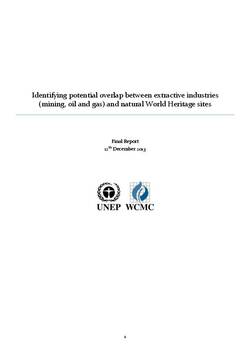 Identifying potential overlap between extractive industries (mining, oil and gas) and natural World Heritage sites .pdf
Identifying potential overlap between extractive industries (mining, oil and gas) and natural World Heritage sites .pdf
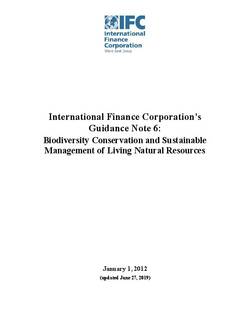 International Finance Corporation’s Guidance Note 6: Biodiversity Conservation and Sustainable Management of Living Natural Resources .pdf
International Finance Corporation’s Guidance Note 6: Biodiversity Conservation and Sustainable Management of Living Natural Resources .pdf
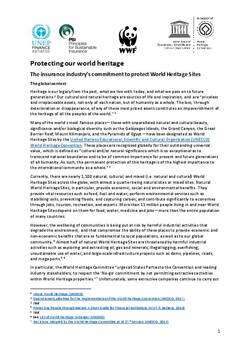 Protecting our world heritage: The insurance industry’s commitment to protect World Heritage Sites .pdf
Protecting our world heritage: The insurance industry’s commitment to protect World Heritage Sites .pdf
Decisions / Resolutions (13)
The World Heritage Committee,
- Having examined Document WHC/21/44.COM/7,
- Recalling Decisions 40 COM 7, 41 COM 7, 42 COM 7, 43 COM 7.2 and 43 COM 7.3, adopted at its 40th (Istanbul/UNESCO, 2016), 41st (Krakow, 2017), 42nd (Manama, 2018) and 43rd (Baku, 2019) sessions respectively,
Emergency situations resulting from conflicts
- Deplores the loss of human life and the degradation of humanitarian conditions resulting from the prevailing conflict situations in several countries, and continues to express its utmost concern at the devastating damage sustained and the continuing threats facing cultural and natural heritage in regions of armed conflict;
- Urges again all parties associated with conflicts to refrain from any action that would cause further damage to cultural and natural heritage, including their use for military purposes, and also urges States Parties to fulfil their obligations under international law by taking all possible measures to protect such heritage, in particular the safeguarding of World Heritage properties and sites included in Tentative Lists;
- Reiterates its utmost concern about the continuing threats of wildlife poaching and illegal trafficking of wildlife and timber products linked to impacts of armed conflict and organized crime, which is eroding the biodiversity and Outstanding Universal Value (OUV) of many World Heritage properties around the world, and further urges States Parties to take the necessary measures to curb this problem, including through the implementation of the Convention on International Trade in Endangered Species of Wild Fauna and Flora (CITES);
- Also reiterates its utmost concern at the increase in illicit trafficking of cultural objects, resulting from armed conflicts, and appeals to all States Parties to cooperate in the fight against these threats, and for cultural heritage protection in general, including through the ratification of the 1970 Convention and the 1954 Convention and its two Protocols, as well as the implementation of United Nations Security Council Resolutions 2199 (2015), 2253 (2015) and 2347 (2017);
- Reiterates its call upon the international community to further support the safeguarding of the cultural and natural heritage of countries affected by conflict, through earmarked funds or through contributions to the UNESCO Heritage Emergency Fund;
Recovery and Reconstruction
- Welcomes the continued reflection on recovery and reconstruction and the broad dissemination of the Warsaw Recommendation in multiple languages as a basis for further reflections and also welcomes the dedicated webpage established by the World Heritage Centre;
- Expresses its gratitude to the Polish authorities for the organization of the webinar “The invincible city: Society in cultural heritage recovery” in October 2020 and to the Arab Regional Centre for World Heritage (ARC-WH) for the “Conference on heritage reconstruction - its economic, social, and psychological aspects in the process of post-trauma recovery” (Bahrain, March 2021);
- Takes note of the various resources already published and in the process of publication;
- Noting the value of accurate pre-existing documentation in the recovery of built and other heritage following destruction, strongly encourages the States Parties and all other stakeholders of the Convention to stimulate the documentation of heritage structures, including through cutting-edge digital technologies, to create databases of documentation for future reference;
Post-2020 Global Biodiversity Framework
- Notes with utmost concern the results of the Intergovernmental Science-Policy Platform on Biodiversity and Ecosystem Services (IPBES) Global Assessment Report on Biodiversity and Ecosystem Services, which shows that nature is declining globally at rates unprecedented in human history and that no significant progress has been achieved on most of the 20 Aichi Biodiversity Targets, and encourages the Parties of the Convention on Biological Diversity (CBD) to adopt an ambitious post-2020 Global Biodiversity Framework (GBF), which can bring about the transformative change needed to halt the loss in biodiversity;
- Considers that the post-2020 GBF should provide a common framework for all Biodiversity-related Conventions and build on the strengths of each convention, and strongly encourages the Parties of CBD to take into account the recommendations of the expert meeting “Harnessing the power of World Heritage for a better future: World Heritage and the post-2020 Global Biodiversity Framework” in the post-2020 GBF to recognize and better integrate the contribution of the World Heritage Convention to global biodiversity conservation;
- Requests the World Heritage Centre and IUCN to continue to engage with the preparatory process of the post-2020 GBF, in order to advance consideration of the World Heritage Convention;
- Also requests the States Parties to ensure that there is effective liaison between the respective national focal points for the CBD and the World Heritage Convention, to ensure that considerations relevant for the Convention are integrated in the GBF, and that the contributions of natural and cultural World Heritage properties, sites on national Tentative Lists, and other internationally designated sites are fully integrated and supported within National Biodiversity Strategy and Action Plans (NBSAPs);
- Further requests the World Heritage Centre and IUCN to report back at its 46th session, with recommended policies and actions to support the adopted post-2020 GBF be taken into account in the processes of the World Heritage Convention;
- Requests furthermore the World Heritage Centre and the Advisory Bodies to consider how the relevance of these proposals for mixed, cultural landscapes and other relevant cultural World Heritage properties, including those cultural properties that overlap with Key Biodiversity Areas, might contribute to the anticipated Joint Programme of Work on the Links between Biological and Cultural Diversity to ensure further integration of nature and culture in the post-2020 GBF and to help achieve its vision of living in harmony with nature by 2050, and report to its 46th session on the approved Programme and how the World Heritage Convention can contribute to its implementation;
- Takes note of the need for additional funding to be provided to support the achievement of biodiversity goals within World Heritage properties, in order to address their contribution to the GBF, and invites the Conference of the Parties of the CBD, in accordance with its decision XIII/21, to take these resourcing needs into account in formulating strategic guidance for the eight replenishment of the Global Environment Facility (GEF) Trust Fund and other international finance mechanisms to support the GBF, considering all elements provided in Section II.C of Document WHC/21/44.COM/7;
Buffer zones
- Noting that a number of World Heritage properties lack formal buffer zones, in particular those on the List of World Heritage in Danger, reaffirms the increasing importance of effective buffer zones to support the protection and management of Outstanding Universal Value (OUV) and building greater resilience of properties to external threats,
- Recalling Decision 32 COM 7.1 and the 2008 expert workshop on World Heritage and Buffer Zones with its specific recommendations to improve guidance, enhance capacity and refine the Operational Guidelines concerning buffer zones,
- Urges States Parties, with the support of the World Heritage Centre and the Advisory Bodies, to:
- Incorporate well-designed buffer zones based on a holistic understanding of natural as well as human induced factors affecting the property, supported by reinforcing relevant legal, policy, awareness and incentive mechanisms, into new nominations and where appropriate into existing properties to ensure enhanced protection of World Heritage properties,
- Place particular emphasis on strategic environmental assessment and impact assessments for potential projects within buffer zones to avoid, negative impacts on OUV from developments and activities in these zones,
- Develop buffer zone protection and management regimes that optimize the capture and sharing of benefits to communities to support the aspirations of the 2015 Policy for the integration of a Sustainable Development Perspective into the processes of the World Heritage Convention,
- Ensure buffer zones are supported by appropriate protection and management regimes in line with the property’s OUV, that build connectivity with the wider setting in cultural, environmental and landscape terms;
- Encourages the States Parties, the World Heritage Centre and the Advisory Bodies, through extra-budgetary support, to revisit and update the recommendations arising from the 2008 expert workshop to enhance capacity through the development of best practice guidelines for designing, establishing, protecting and managing World Heritage buffer zones;
“No-Go” commitment
- Welcomes the continued efforts of the World Heritage Centre, IUCN and other partners to expand the “No-go” commitment to other extractive companies, the banking and insurance sector, the hydropower industry and other relevant companies, commends ENGIE and bp for subscribing to the commitment, and takes note of the initial commitment of Eni, noting the need to strengthen it in order to meet the requests made in previous Committee decisions;
- Reiterates its request to all relevant private and public sector companies to integrate into their sustainability policies, provisions for ensuring that they are not financing or implementing projects that may negatively impact World Heritage properties and that the companies they are investing in subscribe to the “No-go” commitment, and invites these companies to lodge their adopted policies with the UNESCO World Heritage Centre;
- Also welcomes the global insurance industry Statement of commitment to protect the Outstanding Universal Value of World Heritage properties, developed with the UNEP Finance Initiative Principles for Sustainable Insurance (PSI), also commends the 17 major insurance companies and other supporting institutions of the insurance sector that have so far adhered to the Statement and invites other insurance companies to do so;
- Further welcomes the guidance provided by the International Finance Cooperation (IFC) of the World Bank on Performance Standard 6 on Biodiversity Conservation and Sustainable Management of Living Natural Resources that investment projects in natural and mixed World Heritage properties will not be acceptable for financing, with the possible exception of projects specifically designed to contribute to the conservation of the area;
- Acknowledges with appreciation the financial support of the Government of Flanders (Belgium) for this work and reiterates its request to the World Heritage Centre, in cooperation with the Advisory Bodies, to continue the fruitful dialogue with extractive industries the hydropower industry and other industries, the banking, insurance and investment sector, in line with its Decision 40 COM 7;
Fire: impacts and management
- Acknowledging the extensive damage of fires to natural and cultural World Heritage properties since 2019, and the growing threat of forest and bushfires to certain natural properties and their cultural values, including as a result of climate change impacts,
- Requests States Parties to implement best practice fire management strategies to ensure the protection and management of Outstanding Universal Value (OUV) including, where appropriate, to:
- Prepare site-level fire vulnerability and risk assessments, mitigation, Risk Preparedness, response and recovery plans in the event of potential severe fire impacts on heritage values,
- Incorporate fire research, monitoring of impact, emergency response and mitigation and preparedness measures into management decisions,
- Work with stakeholders to raise awareness on fire risks among communities and build greater capacity to respond and recover following fires,
- Consider customised approaches and strategies that reflect the characteristics and circumstances of naturally and anthropogenically generated fires,
- Explore the potential of new technologies for application in fire managing strategies, including monitoring, and firefighting systems, that will not have negative impact on OUV of the properties,
- Take strong actions to address human-induced climate change in line with global United Nations Framework Convention on Climate Change (UNFCCC) commitments;
Urban pressures on cultural World Heritage properties
- Notes that the pressures on historic urban areas arising from inappropriate or inconsistent development controls, rapid, uncontrolled and planned development, including large development projects, additions that are incompatible in their volume, mass tourism, as well as the accumulated impact of incremental changes have continued within numerous World Heritage properties and in their buffer zones and settings, and considers that these present potential and actual major threats to the Outstanding Universal Value (OUV) of properties, including their integrity and authenticity, as well as increasing their vulnerability to disasters, including those resulting from climate change;
- Also notes the unrelenting pressures of urbanization and urban development in recent years, the essential contribution of local communities, and the consequent need to support sustainable, compatible, and inclusive livelihoods for local communities and embed stakeholder engagement in management systems and processes, with a view to seeking solutions to protecting heritage in the framework of sustainable urban development to counter and manage the impacts of this ever-present threat;
- Notes with appreciation the outcomes of the International Workshop on Historic Urban Contexts in Fukuoka, Japan, in January 2020 (Fukuoka Outcomes) as well as the World Heritage City Lab in June 2020 that proposed several useful recommendations;
- Calls on States Parties to implement the 2011 UNESCO Recommendation on the Historic Urban Landscape (HUL) in World Heritage properties with urban characteristics, in particular, following the methodology and recommendations of the Fukuoka Outcomes and the World Heritage City Lab, and use the opportunity of the 10th anniversary of the HUL Recommendation in 2021 to support key actions to implement the HUL Recommendation also in line with the 2030 Agenda and the New Urban Agenda;
- Stresses the importance of carrying out Heritage Impact Assessments to evaluate and thereby avoid or manage potential threats to the OUV of the property arising from new urban development projects;
- Also emphasizes the need to enhance resilience and recovery of World Heritage properties in urban areas vulnerable to climate change related impacts, in line with the HUL Recommendation and the World Heritage City Lab outcomes, while also enhancing the livability of the properties and their surrounding for their inhabitants;
Heritage Impact Assessments / Environmental Impact Assessments
- Welcomes the new Guidance and Toolkit for Impact Assessment in a World Heritage context through collaboration between the Advisory Bodies and the World Heritage Centre, and thanks the State Party of Norway for supporting this work through the ICCROM-IUCN World Heritage Leadership Programme;
- Requests States Parties to carry out subsequent Environmental Impact Assessment/Heritage Impact Assessment in line with the new guidance;
- Calls upon States Parties and organizations to provide additional funding and support for compiling the guidance on Strategic Environmental Assessment and support other capacity building activities on impact assessments;
Conservation of fabric, skills and traditional and contemporary technologies
- Recognizes that repair after disasters as well as continued maintenance over time of the integrity and authenticity of the fabric that contributes to the Outstanding Universal Value (OUV) of cultural and mixed World Heritage properties require specific and specialist skills-sets and crafts, knowledge sets and systems often based in cultural-specific technologies developed over many generations;
- Notes that the challenges encountered in the maintenance and restoration of the physical fabric of cultural and mixed World Heritage properties often arise from the lack of appropriate knowledge and skills among craftspeople, as well as a lack of appropriate historically developed and utilised materials;
- Encourages the States Parties and all other stakeholders of the Convention to:
- Stimulate existing (and develop new) research programmes on traditional methods, technologies and materials, and encourage (and, where necessary support) the intergenerational transmission of traditional and contemporary restoration and maintenance skills, and also embed these in management systems, thereby supporting viable professions for the maintenance of physical human-made attributes that contribute to the OUV of cultural and mixed World Heritage properties,
- Facilitate the development of innovative bespoke technical approaches that enable the long-term sustainable physical conservation of significant fabric, where traditional practices can no longer address changing circumstance,
- Assist in the global dissemination of traditional knowledge, skills and methods for restoration and maintenance of physical fabric through exchanges, publications, digital and other media to benefit the maintenance and restoration of the physical fabric of cultural and mixed World Heritage properties;
Earth observation for World Heritage conservation
- Recalling that Earth observation satellite technologies, spatial data and analysis tools have tremendously improved over the past decade and that they provide powerful additional means for decision-makers and stakeholders of the Convention to find comprehensive solutions to today’s global challenges for World Heritage properties,
- Takes note with satisfaction that the World Heritage Centre, in collaboration with the Group on Earth Observation (GEO) Secretariat and GEO Greek Office, has recently launched the Urban Heritage Climate Observatory (UHCO) as a GEO Community Activity that applies earth observation tools to understand and document the impacts of climate change on World Heritage cities and invites States Parties to contribute to the UHCO with data, expertise, networks, and financial resources;
- Requests States Parties, the World Heritage Centre, the Advisory Bodies, UNESCO Category 2 Centres and other relevant institutions to continue exploring collaborative partnerships, which apply innovative technological advances in remote sensing to the improved monitoring and protection of World Heritage properties;
- Reiterates its encouragements to States Parties to invest in the necessary institutional and individual capacity needed to make full use of such Earth observation technologies for the early detection of activities potentially harmful to the Outstanding Universal Value of World Heritage properties and to better understand trends and respond appropriately.
The World Heritage Committee,
- Having examined Document WHC/19/43.COM/5D,
- Recalling Decisions 36 COM 5C, 38 COM 5D, 39 COM 5D, 40 COM 5C, 41 COM 5C, and 42 COM 17 adopted respectively at its 36th (Saint Petersburg, 2012), 38th (Doha, 2014), 39th (Bonn, 2015), 40th (Istanbul/UNESCO, 2016), 41st (Krakow, 2017) and 42nd (Manama, 2018) sessions respectively, as well as Resolution 20 GA 13, adopted by the General Assembly at its 20th session (UNESCO, 2015),
- Takes note of the African States Parties’ unique biodiversity and richness and their immense wealth of cultural heritage and local knowledge that have come down to humanity so far, and that must be conserved and passed on to future generations;
- Welcomes with appreciation the activities of the World Heritage Centre along with Field Offices, the Advisory Bodies, the African World Heritage Fund (AWHF) and other partners in raising awareness and building capacities around various issues related to World Heritage and sustainable development in Africa as well as the efforts towards developing policy and assessment tools and requests that these efforts be pursued;
- Recognizes the specifically delicate task of balancing World Heritage and Sustainable Development by the least developed countries, notably of the African region, given that it is faced with a disproportionally higher level of poverty globally;
- Further recognizes the need to employ innovative and transformative solutions for reconciling World Heritage and Sustainable Development that will take into account the nature, complexity and specificity of socio-economic constraints that these less developed countries continue to face;
- Takes note of the Position Paper on World Heritage and Sustainable Development in Africa adopted in October 2018 by the African Union through resolution STC/YCS-3/MIN/Report 67, as acknowledged in paragraph 20 d) of the Document WHC/19/43.COM/6;
- Recalls its Decision 37 COM 7 (Part III) which urges all States Parties to the World Heritage Convention and leading industry stakeholders, to respect the International Council on Mining & Metals (ICMM) “No-go” commitment by not permitting extractive activities within World Heritage properties, and by making every effort to ensure that extractive companies located in their territory cause no damage to World Heritage properties, in line with Article 6 of the Convention;
- Reiterates the need to integrate the protection of the Outstanding Universal Value (OUV) of World Heritage properties with inclusive and sustainable development needs through the effective implementation of the World Heritage Sustainable Development Policy (WH-SDP) aligned with the 2030 Agenda for Sustainable Development; the protection of the Outstanding Universal Value should be furthermore ensured by including Environmental Impact Assessment (EIA), Heritage Impact Assessment (HIA), Strategic Environmental Assessment (SEA), in national and international development projects, in accordance with Paragraph 172 of the Operational Guidelines;
- Calls upon the African States Parties to strengthen governance of World Heritage properties and mainstream the WH-SDP principles in national and local conservation and management activities in and around World Heritage properties and processes related to World Heritage in Africa, and to mainstream them in national and local plans for development;
- Further calls upon African States Parties to focus their development efforts to benefit local communities, including them in the decision-making, and building on their knowledge and needs with progressive and proactive conservation of natural and cultural heritage; and to create enabling environments for innovative solutions inclusive of green and blue economies while progressing towards other SDGs;
- Calls upon all States Parties to the World Heritage Convention as well as international agencies and development partners, international finance institutions, industries, private sector, and other partners including multi and bi-lateral partners to join in ensuring policy coherence and harness synergies in multilateral agreements, investments, and protocols. These include the UN 2030 Agenda, and the “Africa 2063” Agenda as well as the WH-SDP to deliver multiple benefits, with inclusive governance mechanisms that bring all round benefits to the local communities in and around World Heritage properties;
- Thanks the States Parties and partners who have generously contributed to strengthening sustainable development in Africa and invites all States Parties to the World Heritage Convention to support, financially and through other means, awareness-raising and capacity-reinforcement programmes at various levels as well as activities aimed at developing guidance, innovative solutions, tools, mechanisms, and strategies for integrating heritage conservation into sustainable development policies and programmes and mainstreaming the sustainable development approach in conservation and management activities in Africa;
- Also invites the Secretariat and Advisory Bodies, in collaboration with African States Parties, the African World Heritage Fund (AWHF) and other stakeholders to spearhead research into innovative solutions for sustainable development, providing measures at the operational level, that guide and coordinate the efforts of the African States Parties to the World Heritage Convention for the conservation of OUV in World Heritage properties, both cultural and natural, and their contribution to the sustainable development of local communities in particular; and also to establish a platform of good practices in integrating heritage conservation with sustainable development for African World Heritage properties;
- Requests the World Heritage Centre to present, at its 44th session in 2020, a progress report on Priority Africa, Sustainable Development and World Heritage.
The World Heritage Committee,
- Having examined Documents WHC/18/42.COM/7, WHC/18/42.COM/7A, WHC/18/42.COM/7A.Add, WHC/18/42.COM/7A.Add.2, WHC/18/42.COM/7B and WHC/18/42.COM/7B.Add and WHC/18/42.COM/7B.Add.2,
- Recalling Decisions 40 COM 7 and 41 COM 7, adopted at its 40th (Istanbul/UNESCO, 2016) and 41st (Krakow, 2017) sessions respectively,
- Thanks the State Party of Bahrain for having organized a World Heritage Site Managers Forum (Manama, 2018), as a capacity-building exercise aiming at increasing the understanding of the World Heritage decision-making process among site managers, in order to achieve a more effective protection of the Outstanding Universal Value (OUV); acknowledges the importance and benefit of this Forum and considers that it should be convened in conjunction with all future sessions of the World Heritage Committee;
- Takes note of the Statement of Participants to the Forum and encourages States Parties to support the participation of their respective site managers to future fora and other capacity-building opportunities in order to enable them to provide appropriate information with regard to the management of their respective sites;
Statutory matters related to Reactive Monitoring
Reactive Monitoring evaluation -
Takes note with appreciation that the World Heritage Centre has launched an evaluation of the Reactive Monitoring process and thanks the State Party of Switzerland for its financial support to this activity;
- Notes with concern that some properties have remained on the List of World Heritage in Danger for more than ten years; this raises questions on whether the OUV has been maintained and requests the World Heritage Centre to establish an inclusive working mechanism for assessing the OUV of these sites, and to present a report during the 44th session;
- Urges States Parties along with other stakeholders to actively contribute to the evaluation of the Reactive Monitoring process to ensure this mechanism remains a valuable indicator and overview of the state of conservation of heritage;
- Also takes note that the Secretariat has prepared audio-visual communication and outreach material related to the List of World Heritage in Danger;
- Encourages all stakeholders of the World Heritage Convention to engage in the promotion of a better understanding of the implications and benefits of properties being inscribed on the List of World Heritage in Danger, and to develop appropriate information material in this regard with a view to overcome the negative perceptions of the List of World Heritage in Danger;
- Requests that the Reactive Monitoring Evaluation includes options for process improvements for sites on the List of World Heritage in Danger, in particular how actions recommended by Reactive Monitoring missions to assist States Parties meet their Desired state of conservation should be incorporated into the costed Action Plans decided by the World Heritage Committee in its Decision 41 COM 14;
- Further requests the World Heritage Centre develop a proposal, for sharing in the World Heritage Market Place, for funds to support a workshop to assist States Parties with sites on the List of World Heritage in Danger to develop and implement prioritized, staged and costed actions plans, and notes that these plans can be linked to requests for international assistance and shared in the Market Place;
- Recognizing the importance of focusing on those properties of greatest concern, recommends that, with effect from the 43rd session of the Committee, the World Heritage Centre considers geographical and thematic distribution of properties as additional criteria when determining which properties to open for discussion under Agenda items 7A and 7B;
Dialogue with civil society - Welcomes the continued interest of civil society organizations in the Convention, acknowledging the important contribution that can be made to the promotion and conservation of heritage on the ground and to capacity-building;
- Also welcomes the initiative of the World Heritage Centre to open the consultation processes related to the Convention to a larger number of stakeholders, including civil society;
- Takes note of the World Heritage Civil Society Workshop organized further to the initiative of World Wildlife Fund (WWF) in March 2018, which discussed how civil society participation in the Convention, and specifically in World Heritage Committee sessions, can be further improved;
- Encourages again States Parties and civil society organizations to continue to explore possibilities to further civil society engagement in the Convention, both by contributing to enhanced conservation of heritage on the site and national level and by providing relevant input to the heritage related debate at the global level;
Emergency situations resulting from conflicts - Deplores the loss of human life as well as the degradation of humanitarian conditions resulting from the conflict situations prevailing in several countries, and expresses its utmost concern at the devastating damage sustained and the continuing threats facing cultural and natural heritage in general;
- Urges all parties associated with conflicts to refrain from any action that would cause further damage to cultural and natural heritage and to fulfill their obligations under international law by taking all possible measures to protect such heritage, in particular the safeguarding of World Heritage properties and the sites included in the Tentative List;
- Also urges the States Parties to adopt measures against World Heritage properties being used for military purposes and to stop uncontrolled development;
- Also expresses its utmost concern about the impacts of conflicts causing an escalation of the already severe poaching crisis in central Africa, as armed groups are financing their activities through illegal wildlife trade, which is having a severe impact on wildlife populations, thereby degrading the Outstanding Universal Value (OUV) of natural World Heritage properties;
- Appeals to all Member States of UNESCO to cooperate in the fight against the illicit trafficking of cultural objects and illegal wildlife trade, as well as cultural heritage protection in general, including through the implementation of the Convention on International Trade in Endangered Species of Wild Fauna and Flora (CITES), and of United Nations Security Council Resolutions 2199 (2015), 2253 (2015) and 2347 (2017) and of the 1970 Convention on the Means of Prohibiting and Preventing the Illicit Import and Export and Transfer of Ownership of Cultural Property;
Emergency situations resulting from natural disasters
- Welcomes the efforts undertaken by the World Heritage Centre to implement the Strategy for Reducing Risks from Disasters at World Heritage Properties;
- Urges States Parties, in coordination with the World Heritage Centre, to give priority within international assistance in implementing emergency measures to mitigate significant damages resulting from natural disasters that are likely to affect the Outstanding Universal Value of World Heritage properties;
- Encourages States Parties and other stakeholders to further strengthen international cooperation aiming at mitigating impacts of major natural disasters affecting World Heritage properties and reducing vulnerabilities on lives, properties and livelihoods;
Other conservation issues
Reconstruction - Thanks the Government of Poland for hosting the International Conference on Reconstruction “The Challenges of World Heritage Recovery” (Warsaw, 6-8 May 2018), providing a forum for review of specific case studies and understanding of the role of reconstruction in recovery, especially in post-conflict and post-disaster situations;
- Welcomes the Warsaw Recommendation providing clear principles on reconstruction and recovery and requests the World Heritage Centre and the Advisory Bodies to broadly disseminate it among States Parties, World Heritage stakeholders and partner organizations;
- Also requests the World Heritage Centre and the Advisory Bodies to continue the reflection and report back to its 43rd session in 2019 on the implementation of the Warsaw Recommendation;
- Encourages the ongoing cooperation with the World Bank and with United Nations agencies in addressing the challenges of World Heritage recovery and reconstruction;
Climate Change
- Expresses its continued concern about the impacts of climate change on the Outstanding Universal Value (OUV) of World Heritage properties and reiterates the importance of States Parties undertaking the most ambitious implementation of the Paris Agreement of the United Nations Framework Convention on Climate Change (UNFCCC), by holding the increase in the global average temperature to well below 2 °C above pre-industrial levels and by pursuing efforts to limit the global average temperature increase to 1.5 °C above pre-industrial levels, recognizing that this would significantly reduce the risks and impacts of climate change;
- Notes with appreciation the initiatives taken by the World Heritage Centre and the Advisory Bodies to advance work on the updating of the Policy Document on the impacts of climate change on World Heritage properties;
- Requests that the development of the updated Policy Document include consultation with States Parties, the Advisory Bodies and civil society, and be completed for consideration by the Committee at its 43rd session in 2019;
- Expresses its gratitude to the State Party of Germany for the organization of a workshop on World Heritage and Climate Change (Vilm, October 2017), to the State Party of the Netherlands for its generous support to the updating of the Policy Document and to the State Party of France for its generous support to the first global scientific assessment of climate change impacts on World Heritage-listed coral reefs;
- Thanks the Secretariat of the UNFCCC for its active participation in the above-mentioned workshop and inputs into the forthcoming broader Policy Document updating process;
Absent or unclear boundaries
- Urges States Parties that still have properties with unclear boundaries and/or buffer zones to undertake the necessary mapping exercises to clarify their boundaries and buffer zones of properties at the time of their inscription, and submit those to the World Heritage Centre for subsequent examination by the World Heritage Committee;
- Reminds States Parties that any change to existing boundaries and buffer zones must be approved by the World Heritage Committee through the applicable procedures, as outlined in paragraphs 163-167 of the Operational Guidelines;
Heritage Impact Assessments/Environmental Impact Assessments (HIAs/EIAs) - Welcomes the increasing use of Heritage Impact Assessments (HIAs) to assess the potential impact of proposed development projects on the Outstanding Universal Value (OUV) of cultural World Heritage properties, and encourages States Parties to use the HIA methodology for all developments within or otherwise affecting cultural World Heritage properties, as part of the accepted decision-making process;
- Stresses the necessity for HIAs and Environmental Impact Assessments (EIAs) to be proportionate to the scope and scale of projects, with simpler assessments being undertaken for smaller projects and Strategic Environmental Assessments (SEAs) for very large projects, and the necessity for assessments to be undertaken in a timely fashion and submitted to the World Heritage Centre for review by the Advisory Bodies, as part of notifications made under Paragraph 172 of the Operational Guidelines;
- Reiterates that HIAs and EIAs should include a dedicated section examining the potential impact of the project on the OUV of the World Heritage property, in accordance with the existing ICOMOS Guidance and IUCN Advice Note;
- Notes that HIAs cannot be assessed as stand-alone documents and requests States Parties to ensure that when HIAs are submitted to the World Heritage Centre for review by the Advisory Bodies that they are accompanied by full details of the project to which they refer;
- Also welcomes the initiative of IUCN and ICCROM to develop further advice on impact assessment for cultural and natural heritage in the framework of the World Heritage Leadership programme with the support of Norway;
Large scale development projects and Strategic Environmental Assessments - Noting with concern that an increasing number of properties are threatened by large-scale development projects including dams, extractive industries, and transportation infrastructure, located both inside and outside their boundaries,
- Also noting that Environmental Impact Assessments (EIAs) and Heritage Impact Assessments (HIAs) do not always allow for a broad enough assessment of the potential impact of these large-scale developments, nor an assessment of a broad enough range of options at an early enough stage in the planning process,
- Requests States Parties to ensure that the potential impacts of such large-scale developments on the Outstanding Universal Value (OUV) of World Heritage properties directly affected or located within their zone of influence are assessed through Strategic Environmental Assessments (SEAs) at an early stage in the development of the overall project, before locations/routes have been fixed and prior to any approvals being given;
- Recalling Article 6 of the Convention, also requests States Parties to systematically inform the World Heritage Centre, in accordance with Paragraph 172 of the Operational Guidelines, of any planned large-scale development projects in their territories that may impact on the OUV of a property, even if the property concerned is situated on the territory of other States Parties, and to ensure that these impacts are assessed as part of the SEA of the project concerned;
Tourism and Visitor Management - Acknowledging the contribution of sustainable tourism to the 2030 Agenda on Sustainable Development and the positive impact it can have on local communities and the protection of World Heritage properties, nevertheless notes with concern that the number of properties negatively affected by inadequate visitor management and tourism infrastructure development continues to increase;
- Requests States Parties to develop Visitor Management Plans that assess appropriate carrying capacity of properties for visitors and address the issue of unregulated tourism;
- Encourages the States Parties to support UNESCO in its effort to develop an overall Visitor Management Strategy for World Heritage, with policy recommendations to assist States Parties in addressing the issues of unregulated and unsustainable tourism use and development, and to provide resources to UNESCO for the implementation of the Strategy;
Impact of sports facilities and activities on World Heritage properties - Welcomes the continued agreement between IUCN and the International Olympic Committee (IOC) aiming at integrating biodiversity considerations in IOC’s processes, and takes note of the Sport and Biodiversity guide launched by IUCN as the first in a series of reports that will provide guidance to the sports sector regarding its potential impacts on nature, including on World Heritage properties
- Also welcomes the World Rowing Federation (FISA) commitment to respect and preserve the Outstanding Universal Value (OUV) of natural and mixed World Heritage properties, and calls on other Sport Federations to consider making similar commitments, including for all types of World Heritage, both natural and cultural;
Dialogue with the extractive industries and the finance sector on the “No-go Commitment” - Takes note of the continued dialogue between the World Heritage Centre and the extractive industries on extending the “No-go” commitment to other companies;
- Welcomes the growing interest from the investment sector for the conservation of World Heritage properties and strongly encourages all banks, investment funds, the insurance industry and other relevant private and public sector companies to integrate into their sustainability policies, provisions for ensuring that they are not financing projects that may negatively impact World Heritage properties and that the companies they are investing in subscribe to the “No-go commitment”, and invites them to lodge these policies with the UNESCO World Heritage Centre;
- Requests the World Heritage Centre, in cooperation with the Advisory Bodies, to continue the fruitful dialogue with extractive industries and the investment sector, including reflections on how to make these commitments and policies publically available online to inspire other companies in these sectors to follow suit;
Earth Observation technologies - Noting that Earth Observation satellite technologies and spatial analysis tools have tremendously improved over the past decade and that they provide powerful additional means for decision-makers and stakeholders of the Convention to find comprehensive solutions to today’s global challenges for World Heritage properties,
- Encourages States Parties to make full use of such Earth Observation technologies for the early detection of activities potentially harmful to the Outstanding Universal Value (OUV) of World Heritage properties, such as deforestation, mining, illegal fisheries, agricultural encroachment, etc. and to better understand trends and respond appropriately;
Illegal trade in endangered species and the cooperation with the CITES Convention
- Reiterates its utmost concern about the growing impacts of the illegal trade in endangered species, which is affecting many natural World Heritage properties;
- Welcomes the increased attention to this threat and launches an appeal to all Member States of UNESCO to fully implement Resolution 71/326 of United Nations General Assembly on “Tackling illicit trafficking in wildlife”, including through the implementation of the Convention on International Trade in Endangered Species of Wild Fauna and Flora (CITES), and with the full engagement of transit and destination countries;
- Also welcomes the continued fruitful cooperation between the World Heritage Centre, IUCN and the CITES Secretariat and invites the World Heritage Centre and IUCN to further strengthen this cooperation;
Invasive species - Notes with concern the important number of properties significantly affected by invasive alien species (IAS);
- Recalls its encouragement to States Parties to develop adequately-resourced IAS strategies that emphasize prevention and early warning and rapid response in World Heritage properties;
- Strongly encourages States Parties to incorporate IAS response strategies into climate change mitigation policies for World Heritage properties.
The World Heritage Committee,
- Having examined Documents WHC/16/40.COM/7, WHC/16/40.COM/7A, WHC/16/40.COM/7A.Add, WHC/16/40.COM/7A.Add.2, WHC/16/40.COM/7B, WHC/16/40.COM/7B.Add and WHC/16/40.COM/7B.Add.2,
- Recalling Decision 39 COM 7, adopted at its 39th session (Bonn, 2015),
Emergency situation resulting from conflicts - Deplores the conflict situation prevailing in several countries, the loss of human life as well as the degradation of humanitarian conditions and expresses its utmost concern at the damage sustained and the threats facing cultural and natural heritage in general;
- Urges the States Parties to ratify international instruments such as the Convention for the Protection of Cultural Property in the Event of Armed Conflict and implores States Parties associated with conflicts to refrain from any action that would cause further damage to cultural and natural heritage and to fulfil their obligations under international law by taking all possible measures to protect such heritage, in particular the safeguarding of World Heritage properties and the sites included in the Tentative List;
- Also urges the States Parties to adopt measures that oppose World Heritage properties being used for military purposes;
- Takes note of the progress made by the World Heritage Centre and the Advisory Bodies to launch a reflection on a post-conflict recovery strategy, and of the support extended so far through technical assistance, capacity-building, and exchange of best practices in this regard, and recommends that further support for threatened or damaged World Heritage properties be pursued;
- Notes with concern that the conflict situation in several countries in the world has increased considerably the work load of the World Heritage Centre staff, and that an adequate implementation of the Action Plans for the Emergency Safeguarding of Cultural Heritage in Mali, Syria, Iraq, Libya and Yemen requires additional financial and human resources at the World Heritage Centre and in the UNESCO field offices; also notes the increased demands on the resources of the Advisory Bodies;
- Calls on the international community to provide financial support for the implementation of the UNESCO Action Plans for the Emergency Safeguarding of Cultural Heritage in Syria, Iraq, Libya and Yemen, including for additional human resources at the World Heritage Centre and in the UNESCO field offices;
- Also expresses its utmost concern about the impacts of conflicts causing an escalation of the already severe poaching crisis, as armed groups are financing their activities through illegal wildlife trade, which is having a severe impact on African wildlife, threatening the very survival of species and the Outstanding Universal Value (OUV) of World Heritage properties;
- Launches an appeal to all Member States of UNESCO to cooperate in the fight against the illicit trafficking of cultural heritage objects and illegal wildlife trade, including through the implementation of the Convention on International Trade in Endangered Species of Wild Fauna and Flora (CITES), the ratification of the 1970 Convention on the Means of Prohibiting and Preventing the Illicit Import, Export and Transfer of Ownership of Cultural Property and to pursue the implementation of the United Nations Security Council Resolution 2199 of February 2015 regarding Syria and Iraq;
Other conservation issues
Reconstruction
- Noting that the recent and wide-ranging deliberate destruction of World Heritage properties as a result of armed conflict in Syria, Yemen, Libya, Iraq, Mali and Nigeria, and the devastating earthquakes in Nepal, have brought sharply into focus the issue of reconstruction in World Heritage properties; that several international meetings have taken place or are being planned on reconstruction; and that guidance within the Operational Guidelines is currently inadequate,
- Recommends that more in depth reflection is needed on reconstruction within World Heritage properties as a complex multi-disciplinary process, and that consideration should be given to developing new guidance to reflect the multi-faceted challenges that reconstruction brings, its social and economic context, the short- and long-term needs of properties, and the idea of reconstruction as a process that should be undertaken within the framework of the Outstanding Universal Value (OUV) of the properties;
- Welcomes the offer of the Government of Poland to host an international conference on Reconstruction to provide guidelines to the World Heritage Committee;
Climate Change - Taking note of the agreement reached during the 21st conference (COP21) of the United Nations Framework Convention on Climate Change (UNFCCC) held in 2015, requests the World Heritage Centre and the Advisory Bodies to assist States Parties to implement appropriate management responses to the adverse effects of Climate Change;
- Recommends that the World Heritage Centre strengthen its relations with other organizations working on Climate Change, particularly with the UNFCCC and the Intergovernmental Panel on Climate Change (IPCC) secretariats, and specifically with regard to the effect of Climate Change on World Heritage properties, and also requests the States Parties, the World Heritage Centre and the Advisory Bodies to work with IPCC with the objective of including a specific chapter on natural and cultural World Heritage in future IPCC assessment reports;
- Further requests the World Heritage Centre and the Advisory Bodies to periodically review and update the “Policy Document on the Impacts of Climate Change on World Heritage properties”, so as to make available the most current knowledge and technology on the subject to guide the decisions and actions of the World Heritage community;
Dams - Notes with significant concern that an increasing number of properties are facing potential threats from major dam projects, considers that the construction of dams with large reservoirs within the boundaries of World Heritage properties is incompatible with their World Heritage status, and urges States Parties to ensure that the impacts from dams that could affect properties located upstream or downstream within the same river basin are rigorously assessed in order to avoid impacts on the Outstanding Universal Value (OUV);
Extractive industries - Noting with significant concern that World Heritage properties are increasingly threatened by extractive industries, as confirmed by the 2014 IUCN World Heritage Outlook report, by the World Heritage Centre’s analysis of issues reported in state of conservation reports also revealing the potential threat from extractive activities to cultural properties, and by the 2016 report by the World Wide Fund for Nature (WWF), welcomes the “No-go” commitments to World Heritage properties made by Tullow Oil plc and CEMEX in November 2015 and April 2016 respectively, and reiterates its call on other extractive industry companies and investment banks to follow these examples to further extend the “No-go” commitment;
- Recalling Decision 37 COM 7, once again urges all States Parties to the Convention and leading industry stakeholders to respect the “No-go” commitment by not permitting extractive activities within World Heritage properties, and by making every effort to ensure that extractives companies located in their territory cause no damage to World Heritage properties, in line with Article 6 of the Convention;
Environmental Impact Assessments (EIAs)/Heritage Impact Assessments (HIAs) - Notes with concern that a majority of properties potentially affected by proposed development projects, proposed legal instruments, and proposed management systems have not benefited from an assessment of impacts on their Outstanding Universal Value (OUV) in line with IUCN’s World Heritage Advice Note on Environmental Assessment and ICOMOS’ Guidance on Heritage Impact Assessments for Cultural World Heritage Properties, and requests all States Parties to the Convention to ensure that potential direct, indirect and cumulative impacts on the OUV, including from projects located outside the boundaries of natural and/or cultural World Heritage properties, are specifically assessed within the framework of the EIA and HIA required by the applicable laws and regulations, and that reports of such assessments are submitted to the World Heritage Centre for review by the Advisory Bodies, in accordance with Paragraph 172 of the Operational Guidelines;
- Recalls Article 6 of the Convention according to which “Each State Party to this Convention undertakes not to take any deliberate measures which might damage directly or indirectly the cultural and natural heritage […] situated on the territory of other States Parties to this Convention”, and also requests all States Parties to the Convention to ensure that EIAs and HIAs include an assessment of impacts on the OUV of World Heritage properties situated on the territory of other States Parties, as appropriate;
- Further requests the Advisory Bodies, in consultation with the World Heritage Centre, to consider opportunities to streamline their guidance on impact assessment in order to develop one single guidance document for the assessment of impacts on both natural and cultural properties;
Integrated management, Decision making, Governance - Noting with concern that the lack of an integrated management approach is reported to cause challenges to the coordination of management and decision making processes of properties where different authorities are involved, in particular in the cases of mixed, serial, and transboundary properties, urges States Parties to establish appropriate mechanisms in order to facilitate a coordinated approach to the management of all properties, in line with the requirements of the Operational Guidelines as laid out in Paragraphs 112, 114, and 135, and encourages States Parties with contiguous natural properties on either side of their international borders, which are not listed as transboundary properties, to establish appropriate mechanisms for cooperation between their respective management authorities and ministries;
- Also encourages States Parties to promote recognition and awareness across all relevant national and regional agencies of the World Heritage status of the properties on their territory, and to develop mechanisms to ensure consideration of impacts on Outstanding Universal Value (OUV) in the decision making processes of relevant ministries, before permits are issued for developments that could negatively impact the OUV;
Ground transport infrastructures - Notes with concern that the number of cases of ground transport infrastructure having potential impact on the Outstanding Universal Value (OUV) of World Heritage properties is continuing to grow, and calls upon States Parties to carry out Strategic Environmental Assessments (SEAs) early in the process of transportation planning to allow for potential impacts of the OUV, including those resulting from foreseeable associated future developments, to be identified prior to the development of specific projects;
- Encourages States Parties to carry out Environmental Impact Assessments (EIAs) and Heritage Impact Assessments (HIA) on ground transport projects, once they are designed, with multiple options to ensure that transportation needs can be met with minimal impacts on the OUV of World Heritage properties;
List of World Heritage in Danger - Takes note of its discussions under agenda items 7A and 7B, and requests the World Heritage Centre, in consultation with the Advisory Bodies and States Parties, to promote better understanding of the implications and benefits of properties being inscribed on the List of World Heritage in Danger, and to develop appropriate information material in this regard with a view to overcome the negative perceptions of the List of World Heritage in Danger. The information material should highlight the importance of the protection of the OUV;
Reactive Monitoring - Requests the World Heritage Centre, in cooperation with the Advisory Bodies to evaluate the effectiveness of the Reactive Monitoring including procedures and case studies and to present a preliminary report for the consideration by the World Heritage Committee at its 42nd session in 2018, if funds are available.
The World Heritage Committee,
1. Having examined Document WHC-14/38.COM/7,2. Recalling Decisions 35 COM 12B, 35 COM 12E and 37 COM 7C adopted at its 35th (UNESCO, 2011) and 37th (Phnom Penh, 2013) sessions respectively,
Issues emerging from the 2014 state of conservation reports
3. Noting with regret that issues related to Management Plan / System remain a serious cause for concern, requests all States Parties to ensure that all World Heritage properties are managed in such a manner that their Outstanding Universal Value (OUV) is not put at risk and, whenever necessary, develop/update and fully implement Management Plans or Systems;4. Taking note of the benefits to States Parties of systematically utilizing Heritage and Environmental Impact Assessments in the review of development projects, recommends that States Parties use these tools in assessing projects before they reach a point where the World Heritage reactive monitoring process comes into play;
5. Also noting that tourism development in and around World Heritage properties is a key issue for their management, strongly encourages States Parties to ensure sustainable planning and management of tourism at World Heritage properties and to contribute to the implementation of the World Heritage Centre’s World Heritage and Sustainable Tourism Programme;
6. Reiterating its utmost concern about the continued impacts on World Heritage properties due to the rising pressure from poaching, particularly of elephant, rhinoceros, and valuable timber species, linked to a growing illicit trade, and the increasing involvement of organized crime in this lucrative business, reiterates its request to the World Heritage Centre and IUCN to strengthen their cooperation with the Secretariat of the Convention on International Trade in Endangered Species (CITES) to assist States Parties to implement the measures taken by the 16th Conference of the Parties of the CITES, and urges States Parties to ensure strong international collaboration and coordination to control the illicit trade in flora and fauna and their products;
7. Takes note with concern of the continuing threat posed to World Heritage properties by disasters and conflicts, of the widespread lack of adequate preparedness, and of the need to integrate a concern for heritage within international policies and programmes for disaster risk reduction, and calls on States Parties to ensure that their delegations to the 3rd World Conference on Disaster Risk Reduction (WCDRR), due to take place in March 2015 in Sendai (Japan), are sensitized to this question and promote heritage as an essential consideration in disaster risk reduction;
8. Also requests that States Parties with an interest in the promotion of capacity building on the issues of management, impact assessments, disaster risk management, sustainable tourism management, and poaching and wildlife crimes to liaise with the Advisory Bodies, World Heritage Centre, and UNESCO Category 2 Centres, and support regional or international courses, workshops, and other capacity building activities to improve the capacity of States Parties and site managers to develop and implement these important planning instruments;
Updates on previously reported issues
9. Welcomes the commitment made by TOTAL in June 2013 not to explore or exploit oil or gas inside sites inscribed on the World Heritage List as well as the new policy on World Heritage Sites adopted by the investment bank HSBC not to knowingly provide financial services to support projects which threaten the special characteristics of World Heritage properties and, also taking note of the discussions held between the World Heritage Centre, IUCN and International Petroleum Industry Environmental Conservation Association (IPIECA), calls on other companies in extractive industries and investment banks to follow these examples to further extend the “No go” commitment;10. Also welcomes the progress in the dialogue between the World Heritage Centre, the Advisory Bodies and the International Olympic Committee (IOC) and encourages the development of a mechanism that would allow to identify potential impacts of future Olympic Games on World Heritage properties early on in the process of attributing the Games in order to ensure that these impacts can be avoided or adequately mitigated by the organizing country;
Strategic issues related to the state of conservation of World Heritage properties
11. Also recalling that States Parties concerned shall submit by 1 February to the Committee through the Secretariat, their reports on the state of conservation of specific properties (Paragraph 169 of the Operational Guidelines ),12. Acknowledging that the established minimum two-year cycle for the examination of state of conservation reports for individual properties (except for cases of utmost urgency and for properties inscribed on the List of World Heritage in Danger), associated to a postponed deadline for the submission of the States Parties’ reports would provide an opportunity for improved dialogue between the States Parties, the World Heritage Centre and the Advisory Bodies, decides that States Parties concerned shall submit their state of conservation reports to the World Heritage Centre by 1 December of the year preceding the examination of the property by the World Heritage Committee, with immediate effect, except for properties inscribed on the List of World Heritage in Danger and for cases of utmost urgency, and further requests the World Heritage Centre and the Advisory Bodies to draft a proposal in view of including this new statutory deadline in the Operational Guidelines , for examination by the World Heritage Committee at its 39th session, in 2015;
13. Reminds States Parties of the importance of submitting their state of conservation reports to the World Heritage Centre in one of the working languages of the World Heritage Convention, English or French;
14. Notes with appreciation the high number of States Parties which have authorized the public upload of their state of conservation reports, facilitating their consultation by all stakeholders of the Convention and contributing to an improved transparency of the reactive monitoring process, and reiterates its encouragement to all States Parties to continue do so in the future. Read more about the decision
The World Heritage Committee,
1. Having examined Document WHC-13/37.COM/7A.Add,
2. Recalling Decision 36 COM 7A.4 adopted at its 36th session (Saint-Petersburg, 2012),
3. Addresses its most sincere condolences to the families of the guards killed in operations for the protection of the Park;
4. Expresses its utmost concern as to the degradation of the security situation that has serious repercussions on the state of conservation of the property, notably the loss of control of a part of the property, the increase in organized and armed poaching, and the illegal occupation of several parts of the property with the risk of cancelling the progress accomplished in the implementation of the corrective measures;
5. Recalls the commitments taken by the Congolese Government in the Kinshasa Declaration of January 2011, notably regarding the security of the World Heritage properties and the strengthening of ICCN operational capacities;
6. Reiterates its deep concern that the State Party has not yet revised the authorizations for petroleum exploration in the Park, as requested in its Decision 36 COM 7A.4 , and on the consequences of the declaration of the Minister of Environment indicating that the government envisaged de-gazetting a part of the Park for petroleum exploitation;
7. Expresses its serious concern regarding the project for a new Hydrocarbons Code that would allow petroleum exploitation in protected areas, including World Heritage properties, and requests the State Party to renounce this project;
8. Reiterates its request to the State Party to cancel all the oil exploitation permits granted within the property and recalls the incompatibility of oil and mining exploitation and exploration with World Heritage status;
9. Also recalls its appeal to the TOTAL and SOCO companies to subscribe to the commitments already accepted by SHELL and ICMM (International Council on Mining and Metals) not to undertake petroleum or mining exploration or exploitation within World Heritage properties, and its request to States Parties to the Convention to do their utmost to ensure that the mining or petroleum companies established on their territories do not damage World Heritage properties, in accordance with Article 6 of the Convention;
10. Also requests the State Party to invite a joint World Heritage Centre/IUCN reactive monitoring mission to assess the state of conservation of the property and notably the status of the petroleum exploration projects and the impact of the security situation on the property and, if necessary, to revise the corrective measures and their timetable;
11. Further requests the State Party to submit to the World Heritage Centre, by 1 February 2014 , a detailed report on the state of conservation of the property, including an update of the progress accomplished in the implementation of the corrective measures, for examination by the World Heritage Committee at its 38th session in 2014;
12. Decides to continue the application of the Reinforced Monitoring Mechanism of the property;
13. Also decides to retain Virunga National Park (Democratic Republic of the Congo) on the List of World Heritage in Danger.
Read more about the decisionThe World Heritage Committee,
1. Having examined Documents WHC-13/37.COM/7A, WHC-13/37.COM/7A.Add, WHC-13/37.COM/7A.Add.2, WHC-13/37.COM/7B, WHC-13/37.COM/7B.Add and WHC-13/37.COM/7B.Add.Corr,
I
2. Expresses its utmost concern about the many conflicts which are affecting World Heritage properties and in particular the recent cases where World Heritage properties are intentionally destroyed by parties involved in the conflict, and the people in charge of their protection targeted;
3. Takes note of the efforts of the World Heritage Centre and partners to try to minimize the impacts of conflicts on the properties by raising the awareness of the parties concerned and mobilizing financial support for their conservation, and appreciates the United Nations Security Council resolution 2100 of 25 April 2013 to ensure that, for the first time, the protection of cultural and historical sites, in collaboration with UNESCO, has been included in the mandate of the United Nations Multidimensional Integrated Stabilization Mission in Mali (MINUSMA);
4. Launches an appeal to UNESCO and to the Parties to The Hague Convention for the Protection of Cultural Property in the Event of Armed Conflict (1954), seeks their support for Mali and their cultural and technical cooperation, in particular for establishing property inventories and also requests the implementation of conservation measures for cultural properties threatened by armed conflict in other countries;
II
5. Also expresses its utmost concern about the impacts on World Heritage properties due to the rising poaching pressure on African elephants and rhinoceros linked to a growing illicit trade to Asia, fuelled by soaring prices for rhino horn and ivory and the increasing involvement organized crime in this lucrative business;
6. Welcomes the measures taken by the 16th Conference of the Parties of the Convention on International Trade in Endangered Species (CITES) to help address this poaching crisis and requests the World Heritage Centre and IUCN to strengthen its cooperation with the CITES Secretariat to assist States Parties to implement these measures;
III
7. Also welcomes the relevant conclusions of the “Living with World Heritage in Africa” Conference held in Gauteng, South Africa (26-29 September 2012), which build on the recommendations of the independent review of the “No-go” commitment of the International Council on Mining and Metals (ICCM) concerning mining exploration/exploitation in World Heritage properties, noted in Decision 36 COM 7C ;
8. Notes with concern the growing impact of the extractive industries on World Heritage properties, and urges all States Parties to the Convention and leading industry stakeholders, to respect the “No-go” commitment by not permitting extractives activities within World Heritage properties, and by making every effort to ensure that extractives companies located in their territory cause no damage to World Heritage properties, in line with Article 6 of the Convention;
9. Also requests the World Heritage Centre and the Advisory Bodies to continue a dialogue with the extractive industries on extending the commitment made by Shell and the International Council on Mining and Metals (ICMM) to not explore or develop oil, gas and mineral resources within World Heritage properties to other companies and parts of the industry, and also to ensure that existing and future operations in areas surrounding World Heritage properties are compatible with the protection of their Outstanding Universal Value and do not threaten their integrity;
IV
10. Takes note that guidance on impact assessments is now available from the Advisory Bodies for both natural and cultural properties, and that more detailed joint guidelines are needed to provide a comprehensive overview of how the results of these assessments can be successfully integrated into decision-making processes for land-use planning;
V
11. Thanks the State Party of the Netherlands, and the European Union for their support for the publication of the Managing Natural Heritage Resource Manual in printed versions and encourages other States Parties to the Convention to support translation and dissemination of this resource manual in a range of regional languages.
Read more about the decisionThe World Heritage Committee,
1. Having examined Document WHC-13/37.COM/7B.Add.Corr,
2. Recalling Decision 36 COM 7B.3 adopted at its 36th session (Saint-Petersburg, 2012),
3. Noting the statement made by the State Party of Ethiopia during the 36th session of the Committee (Saint-Petersburg, 2012) to express its concern regarding the decision by the Committee requesting Ethiopia to halt construction of the dam,
4. Regrets that the State Party of Ethiopia has not submitted a progress report on the implementation of the actions requested in its Decision 36 COM 7B.3 , including inviting a joint reactive monitoring mission to Ethiopia;
5. Also regrets that construction of Gibe III and associated projects have continued without ensuring that a Strategic Environmental Assessment (SEA) has been accomplished and reiterates its utmost concern about the potential and ascertained cumulative impacts of the Gibe III dam on Lake Turkana, and the related on-going and planned irrigation projects in the Lower Omo valley and the planned Gibe IV and Gibe V projects, which present a clear threat to the Outstanding Universal Value (OUV) of the property, in accordance with Paragraph 180 (b) of the Operational Guidelines ;
6. Reiterates its request to the States Parties of Kenya and Ethiopia to address this issue on a bilateral basis and conduct a SEA to assess the cumulative impacts of all developments impacting on the Lake Turkana basin in order to identify appropriate corrective measures to ensure that the water level in Lake Turkana, as well as a level of seasonal variation be maintained, which is sufficient to maintain the OUV of the property;
7. Welcomes the confirmation by the State Party of Kenya that no oil exploration will take place within the property but notes that oil exploration or exploitation in the immediate vicinity of the property, in particular in the areas of the lake not included within its boundaries, could represent an important risk to its OUV and would need to be carefully assessed through an Environmental Impact Assessment (EIA), in line with Paragraph 172 of the Operational Guidelines ;
8. Reiterates its call upon Tullow Oil to subscribe to the “No-go” commitment already supported by the International Council on Mining and Metals (ICMM) and Shell not to explore or exploit oil or minerals inside World Heritage properties;
9. Requests the State Party of Kenya to implement the recommendations of the 2012 World Heritage Centre/IUCN monitoring mission to address the significant impacts of poaching, fishing and livestock grazing on the property;
10. Also reiterates its request to the State Party of Ethiopia to invite a joint World Heritage Centre/IUCN reactive monitoring mission to review the impacts of the Gibe III dam and other hydro-electric developments and associated large-scale irrigation in the Omo region on the OUV of Lake Turkana;
11. Urges the States Parties to allow for the completion of the on-going bilateral discussions on the impact of GIBE Dam on the Lake Turkana Property;
12. Also requests the State Party of Kenya, in consultation with the State Party of Ethiopia, to submit to the World Heritage Centre, by 1 February 2014 , a progress report for examination by the World Heritage Committee at its 38th session in 2014, and a state of conservation report by 1 February 2015 for examination at its 39th session in 2015
Read more about the decisionThe World Heritage Committee,
1. Having examined Document WHC-12/36.COM/7A.Add,
2. Recalling Decision 35 COM 7A.4, adopted at its 35th session (UNESCO, 2011),
3. Extends its deepest condolences to the families of guards killed during operations conducted to protect the property, since its last session;
4. Welcomes with satisfaction the significant progress reported by the State Party in the implementation of certain corrective measures, including the resumption of control of 80% of the Park, despite the persistence of pockets of militias in the Park, diminishment of the carbonization problem, the measures taken against encroachment at Lubiliha and the creation of forums for dialogue with the communities to resolve important conflicts;
5. Expresses its deep concern over the granting of a Certificate of Environmental Acceptability for an aeromagnetic and aerogravimetric data gathering campaign, which appears to contradict the Government's decision announced at the 35th session of the Committee to suspend petroleum exploration pending completion of the strategic environmental assessment;
6. Reiterates its request to the State Party to revise its authorizations and not to grant new authorizations for petroleum and mining exploration and exploitation within the property boundaries and recalls its position on the incompatibility of petroleum and mining exploration and exploitation with World Heritage status;
7. Appeals to the TOTAL and SOCO companies to adhere to commitments already made by Shell and ICMM not to undertake petroleum and mining exploration or exploitation within World Heritage properties;
8. Notes that the TOTAL company, in conformity with its current policy of non-exploration of the protected areas of the park, has not undertaken any petroleum or mining exploration or exploitation within the World Heritage properties, and invites it to formally commit to this policy;
9. Requests States Parties to the Convention to make every effort to ensure that petroleum and mining companies in their territory cause no damage the World Heritage properties, in accordance with Article 6 of the Convention;
10. Notes that the report of the State Party refers to an unquantified increase in the numbers of wildlife in some areas of the Park, and considers that it will take time to restore these populations, given that the numbers of most species of large mammals of the plains have been reduced by 50% to 96% since the inscription of the property;
11. Also requests the State Party to undertake aerial surveys of key species to confirm these positive trends and monitor indicators established for the Desired State of Conservation for removing the property from the List of World Heritage in Danger;
12. Urges the State Party to continue the implementation of the corrective measures decided by the Committee at its 35th session (UNESCO, 2011) in accordance with the commitments in the Kinshasa Declaration to rehabilitate the Outstanding Universal Value of the property;
13. Further requests the State Party to submit to the World Heritage Centre, by 1 February 2013, a detailed and quantified report on the conservation status of the property and on progress in implementing corrective measures, for examination by the World Heritage Committee at its 37th session in 2013;
14. Decides to continue the application of the Reinforced Monitoring Mechanism;
15. Also decides to retain Virunga National Park (Democratic Republic of the Congo) on the List of World Heritage in Danger.
Read more about the decisionThe World Heritage Committee,
1. Having examined Document WHC-12/36.COM/7B.Add,
2. Recalling Decision 35 COM 7B.3, adopted at its 35th session (UNESCO, 2011),
3. Takes note of the results of the joint World Heritage Centre/IUCN monitoring mission undertaken to Kenya to assess the state of conservation of the property and in particular the impact of the GIBE III dam project and related developments;
4. Reiterates its utmost concern about the potential and ascertained cumulative impacts on Lake Turkana of the GIBE III dam, the related on-going and planned irrigation projects as well as the planned Gibe IV and V dams, and considers that these developments represent a clear potential threat to the Outstanding Universal Value of the property, in accordance with Paragraph 180 (b) of the Operational Guidelines;
5. Urges the State Party of Ethiopia to invite the joint World Heritage Centre/IUCN mission to review the impacts of the GIBE III dam on the Outstanding Universal Value of Lake Turkana, as was done by the State Party of Kenya;
6. Also urges the State Parties of Kenya and Ethiopia to address this issue on a bilateral basis and conduct a Strategic Environmental Assessment (SEA) to assess the cumulative impacts of all developments impacting on the Lake Turkana basin in order to identify appropriate corrective measures to ensure that the water level in Lake Turkana, as well as a level of seasonal variation be maintained, which is sufficient to maintain the Outstanding Universal Value of the property;
7. Further reiterates its request to the State Party of Ethiopia to immediately halt all construction on the GIBE III dam and related irrigation projects until the SEA is completed and appropriate corrective measures have been identified and implemented;
8. Takes note that oil exploration licences have been granted for exploration blocks which cover part of the property, but that so far no oil exploration activities have been carried out or are planned within the property, and requests the State Party of Kenya to clarify the provision already included within the oil exploration licence on the protection of the World Heritage property, to ensure that no exploration can take place within the property;
9. Calls on Tullow Oil to subscribe to the no-go commitment, already supported by the International Council on Mining and Metals (ICMM) and Shell, not to explore or exploit oil or minerals inside World Heritage properties;
10. Notes the significant impacts of poaching, fishing and livestock grazing on the property reported by the World Heritage Centre / IUCN monitoring mission, and requests the State Party to implement the recommendations of the mission to address these and other management issues, in particular:
a) Conduct a detailed census of key wildlife species to establish their status and develop a baseline to monitor their recovery,
b) Strengthen the efficiency of law enforcement and surveillance based on the results of the MIST monitoring system which is being introduced in the property,
c) Establish a permanent presence of Kenya Wildlife Servive staff in the northern part of Sibiloi National Park as well as on Central and South Island National Parks,
d) Develop in close consultation with representatives of the local pastoralist communities a strategy to diminish grazing pressure in the property, including by identifying grazing areas outside the property and provide them with access to water,
e) Assess the feasibility of reintroducing flagship species which have disappeared from the property such as reticulated giraffe and Grevy’s zebra;
11. Also requests Kenya Wildlife Service and National Museums of Kenya to ensure that the new management plan addresses all three components of the property and covers both the biodiversity and paleontological values;
12. Further requests the State Party of Kenya in cooperation with the State Party of Ethiopia to develop based on the corrective measures identified through the SEA, a timeframe and costed action plan for their implementation as well as a draft Desired state of conservation;
13. Requests furthermore the States Parties of Ethiopia and Kenya to submit to the World Heritage Centre, 1 February 2013, information on the negotiations between Ethiopia and Kenya and a progress report on the implementation of the above mentioned requested actions for consideration by the World Heritage Committee at its 37th session in 2013;
14. Decides not to inscribe Lake Turkana National Parks (Kenya) on the List of World Heritage in Danger before the completion of a mission by the Advisory Bodies to the State Party of Ethiopia as recommended in paragraph 5.
Read more about the decisionThe World Heritage Committee,
1. Having examined Document WHC-09/33.COM/7B,
2. Recalling Decision 32 COM 7B.52, adopted at its 32nd session (Quebec City, 2008),
3. Notes with satisfaction that the State Party has confirmed that prospecting/mining activities are not allowed within the property and its buffer zone, in line with the "No-go" commitment of the International Council for Minerals and Metals (ICMM) in World Heritage properties (2003);
4. Also notes the actions implemented by the State Party to address the specific prospecting permit at the property and urges the State Party to expedite the process for the final cancellation of this permit as soon as possible and inform the World Heritage Centre;
5. Takes note of the results of the 2009 joint World Heritage Centre/ICOMOS reactive monitoring mission, endorses its recommendations and requests the State Party to implement them, particularly in respect to presenting the property and addressing potential threats deried from overgrazing, desertification and plant poaching;
6. Welcomes the State Party's decision not to reduce the buffer zone and invites the State Party to probe the possibility of a potential extension into the Richtersveld National Park to strengthen the sustainability of the Outstanding Universal Value of the cultural landscape, in line with Decision 31 COM 8B.20, paragraph 4a, at the time of inscription;
7. Encourages the State Party to carry out an assessment of the impact of mining activities in areas close to the buffer zone on the Outstanding Universal Value and integrity of the property and to identify measures to comprehensively address them;
8. Requests the State Party to provide three printed and electronic copies of the revised management plan, including measures to address Paragraph 7 above, for review by the World Heritage Centre and the Advisory Bodies;
9. Also requests the State Party to keep the World Heritage Centre informed on the state of conservation of the property and on the progress made in the implementation of the above recommendations.
Read more about the decisionVIII.44 The Committee recalled that in accordance with its request at its twenty-third session, IUCN and the World Heritage Centre planned and organised, in consultation with the International Council on Metals and the Environment (ICME), a technical meeting which analysed case studies on World Heritage and mining. This meeting was held at the IUCN Headquarters (Gland, Switzerland) from 21 to 23 September 2000 and reviewed practical case studies from the following sites: Lorentz National Park, Indonesia; Huascaran National Park, Peru; Doñana National Park, Spain; Camp Caiman Gold Project, French Guyana (adjacent to a Ramsar site); Kakadu National Park, Australia; and Greater St. Lucia Wetlands Park, South Africa.
VIII.45 The Committee noted the deliberations of the twenty-fourth extraordinary session of the Bureau on this matter included in working document WHC-2000/204/4.
VIII.46 The Observer of the United States stated that the discussions at the Bureau session on mining and World Heritage were helpful. This partially stems from the World Commission on Protected Areas (WCPA) position statement on mining and World Heritage that had been discussed at past meetings of the World Heritage Committee and its Bureau. The Rapporteur's report of the twenty-fourth session cited IUCN's view "that this issue has been characterized by a lack of dialogue between conservation and mining interests". He agreed, and applauded IUCN, ICME and the Centre for holding a technical meeting in Gland (Switzerland), that included representatives of mining and conservation interests. He believed that there remained a need for more dialogue on this issue to resolve outstanding issues. As a result, he requested that the Centre and IUCN consider holding a follow-up workshop on this issue to build on the progress made at the Gland meeting. Finally, he informed the Committee that the US House of Representatives Committee on Resources held a hearing on this subject in October 1999. The report of this hearing is available at http:www.house.gov/resources, listed as document 106-80.
VIII.47 The Delegate of Canada supported the comments by the United States of America and recommended that the proceedings of the workshop be published. Concerning the specific recommendations of the workshop, his country would see the preparation of guidelines on World Heritage and mining and the dissemination of the results of the workshop as a priority. The Delegate of Hungary noted that this issue is a breakthrough in terms of a strategic policy development and requested that progress made in this matter be brought back to the next Committee session and that possibly similar strategic issues, such as World Heritage and tourism be raised.
VIII.48 In summing up the discussion, the Chairperson said that the Committee agreed to the establishment of a Working Group on World Heritage and Mining to carry forward the work in this important field.
VIII.49 The Committee noted the recommendations of the report for transmission to the various key actors. The recommendations of the Workshop are contained in Annex XV.
Read more about the decisionX.48 The Committee recalled that, based on discussions of specific cases at its twenty-second session, the former Chairperson, Professor Francioni, recommended the establishment of an informal contact group on mining and World Heritage sites during the annual sessions of the Committee and the Bureau.
X.49 The Committee noted that a dialogue with the mining industry had commenced and that the Centre, IUCN and ICOMOS had been invited by the International Council on Metals and the Environment (ICME) to a working session on "Mining and Protected Areas and other Ecologically Sensitive Sites" on 20 October 1998 in London (UK).
X.50 The Committee was informed that the Bureau (July 1999) took note of the "WCPA Position Statement on Mining and Associated Activities in Relation to Protected Areas" (Information Document) and of further initiatives, including collaboration with UNEP's Division of Technology, Industry and Economics and other units in UNESCO. The Chairperson, noting that the Bureau might wish to reflect on the relevance of WCPA's Position Statement in the light of its deliberations on mining threats to specific sites, suggested that the WCPA Position Statement be submitted as a working document to the twenty-third session of the Committee. The document was presented as WHC-99/CONF.209/20.
X.51 IUCN reported to the Bureau that the statement had been prepared by the WCPA, one of the six commissions of IUCN with more than 1,400 members in 140 countries. The Position Statement on Mining was developed within the WCPA network. IUCN stated that mining is a key issue in many countries and this statement had been developed for the world's protected areas in general, rather than for World Heritage sites specifically. However, the principles in the Position Statement may be applicable. The aims of the Statement are to: (a) provide a global framework to guide WCPA approaches; (b) provide a framework for countries to consider and adapt as needed in local circumstances; (c) establish a framework based on the IUCN protected area categories system which is focused on the objectives of protected area management. Finally, IUCN noted that mining is an issue at many World Heritage sites. IUCN is prepared to continue consultations on this issue, including with UNESCO and UNEP, as well as the mining industry and its International Council on Metals and the Environment (ICME).
X.52 The Representative of ICOMOS commended WCPA for the Position Statement and fully supported it. He underlined that the exploitation of mineral resources and its impacts do not concern only natural sites, but also cultural landscapes and other cultural properties.
X.53 The Delegate of Canada supported the WCPA Position Statement and the ongoing work on protected areas and mining, and stated that there are specific concerns on mining in relation to World Heritage sites. He strongly supported a technical session, which should be carried out in collaboration with the mining industry.
X.54 The Observer of the United States of America wished to ensure that the status of the discussion paper provided by the WCPA as a working paper for the Committee meeting be clarified. The WCPA draft statement was the subject of a recent hearing before the United States Congress, because the impression had been conveyed that it would be proposed to the World Heritage Committee in Marrakesh, to adopt a policy that would ban mining outside World Heritage sites. Some of the confusion on this point occurred because Bureau document prepared for the July session suggested that the WCPA position statement on mining be recommended to the Committee for adoption. It is the understanding of the United States that this document was tabled for information purposes only. It is therefore noted for the record that this document is not recommended for adoption by the Committee. If the Committee chooses to authorize or participate in any follow-up discussions on the subject of mining and World Heritage, it is the position of the United States that these discussions must be fully transparent and open to stakeholders. It is noted, for example, that the International Council on Metals and the Environment (ICME) was invited to comment on the WCPA policy, but the National Mining Association of the United States was not involved at all. The United States Observer further noted that mining policy is an internal matter for sovereign states and that the Committee is not dictating what domestic policies on this issue should be. Any results of follow-up discussions on mining policy will be strictly advisory to the States Parties.
X.55 To further clarify the discussion, she provided a text of the testimony presented at the hearing referenced above, given by the Assistant Secretary for Fish and Wildlife and Parks of the U.S. Department of the Interior, a former head of the U.S. Delegation to the World Heritage Committee. Her statement is provided in Annex IX.
X.56 In responding, IUCN reiterated to the Committee that the WCPA document is for information only, as it is clearly an internal document of IUCN. There is no intention to ban mining outside World Heritage sites, as has been suggested.
X.57 The Delegate of Australia stated his support for the IUCN work on protected areas and noted that collaboration with the mining industry exists, in particular in relation to the IUCN Protected Area Category VI. He informed the Committee that his Government would be pleased to share experiences on this issue.
X.58 The Observer of France commended the approach taken by the Secretariat and IUCN and underlined that there are threats to World Heritage sites. He suggested a code of conduct would be needed. This should also be taken into account in relation to marine sites and oil exploration, in particular in view of the expansion of economic activities.
X.59 The Delegate of Benin shared the view expressed by France and welcomed the debate, as in the past years this issue had been discussed in relation to specific World Heritage sites. He underlined that different regions should be involved in this debate. The Delegate of South Africa noted support for the Position Statement and commented that cultural sites be also taken into account.
X.60 The Director of the Centre and the Chairperson thanked the Committee for the rich debate. The Committee adopted the following decision:
"The Committee
(a) took note of the document in light of its deliberations on threats and potential threats from mining to specific World Heritage properties,
(b) recognized that there may possibly be additional issues and problems that are specific to the management of World Heritage sites facing ascertained and potential impacts from mining projects;
(c) requested the Centre to co-operate with interested UNESCO units, the advisory bodies, UN agencies (such as the UNEP Division of Technology, Industry and Economics in Paris), other concerned agencies and representatives from interested States Parties to the Convention and representatives of the mining industry, to organize a technical meeting to analyse case studies on World Heritage and mining during global events already planned for the year 2000 (e.g. the IUCN World Conservation Congress due to be held in Amman, Jordan, in October 2000), and develop recommendations for review and discussion by the twenty-fourth session of the Committee.
(d) asked the Chairperson to write a letter to the Director- General of IUCN concerning the organization of a technical session on World Heritage and Mining at the World Conservation Congress (Amman, Jordan, in October 2000)."
X.61 The Committee also took note of a debate on two other general issues, relevant to a number of World Heritage sites, discussed by the twenty-third extraordinary session of the Bureau: Fire management/control, and invasive species. The Delegate of Thailand recalled that he had made a statement during the twenty-third extraordinary session of the Bureau.
Read more about the decision


